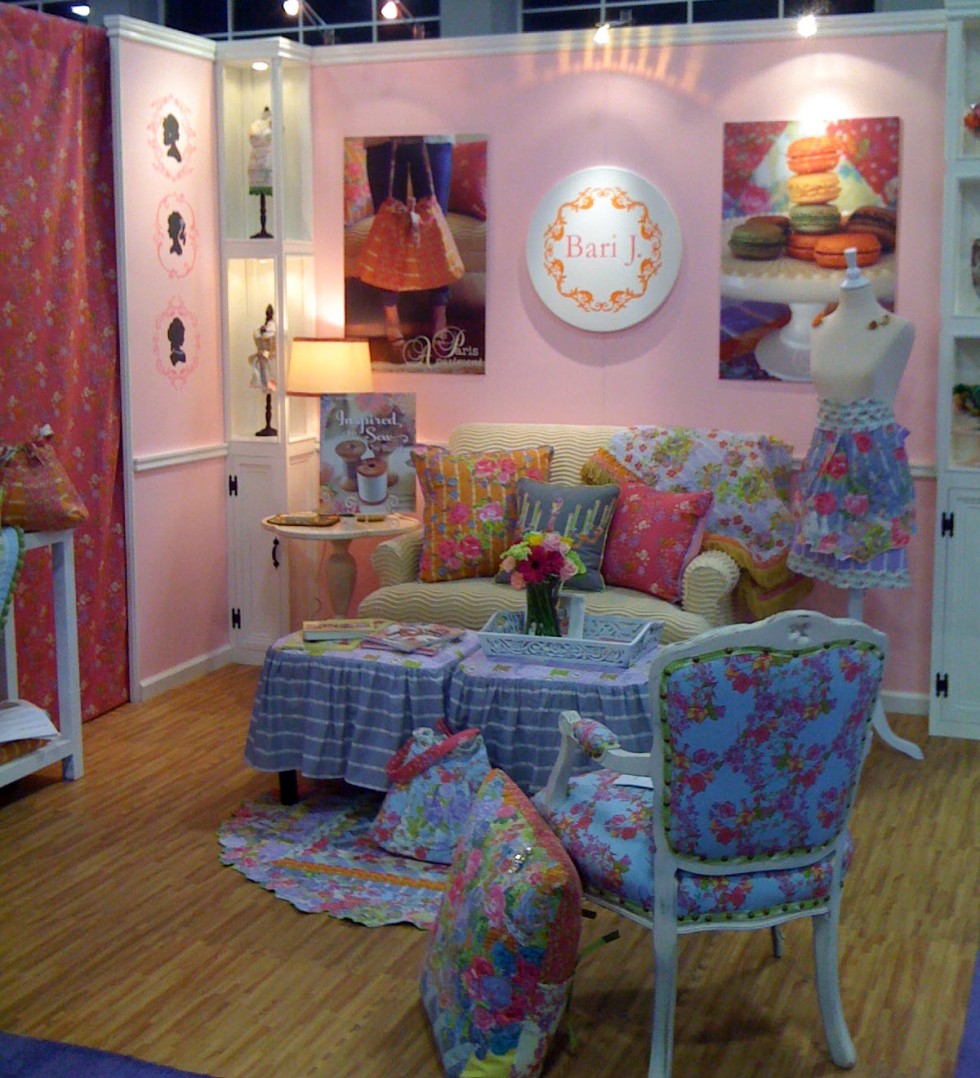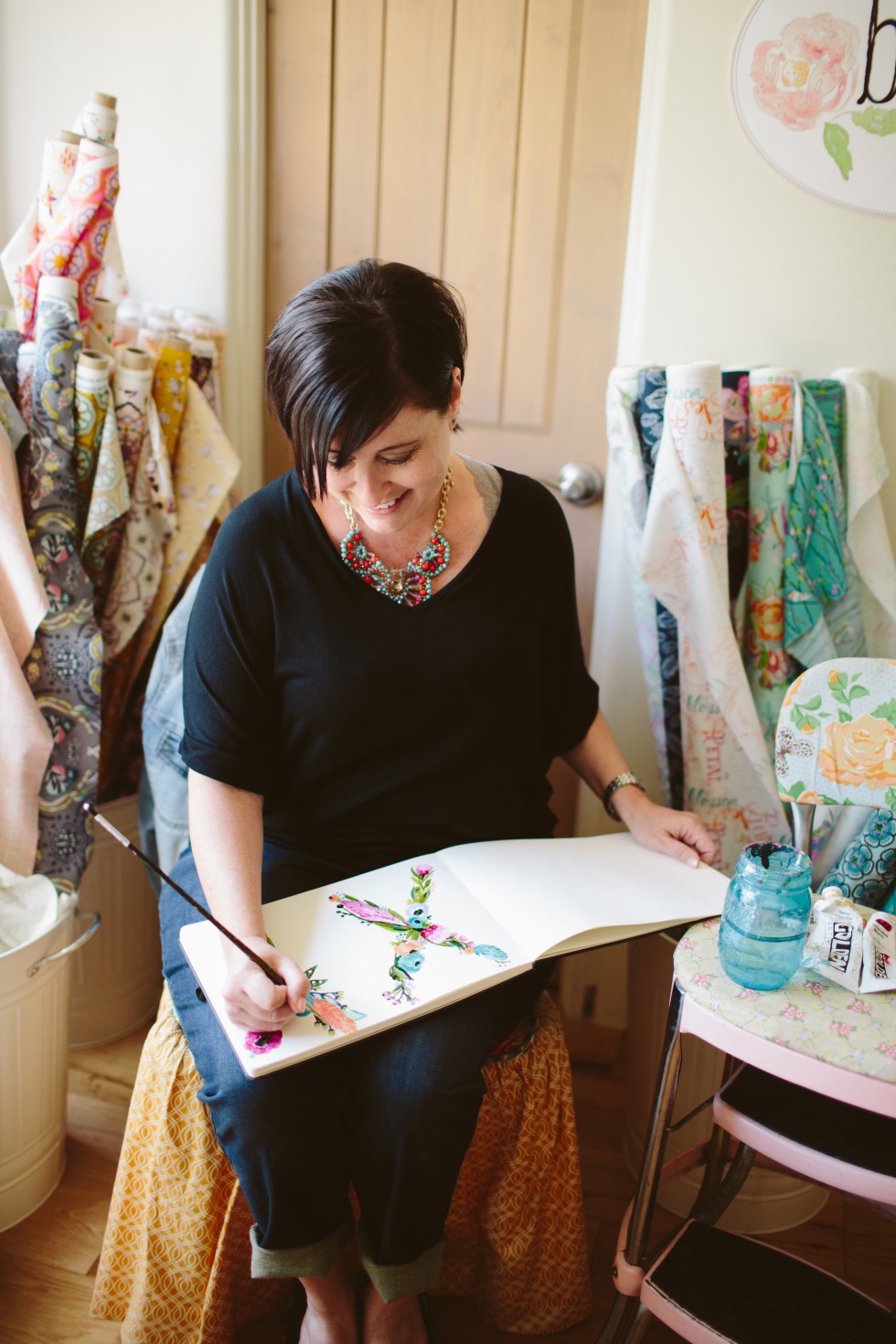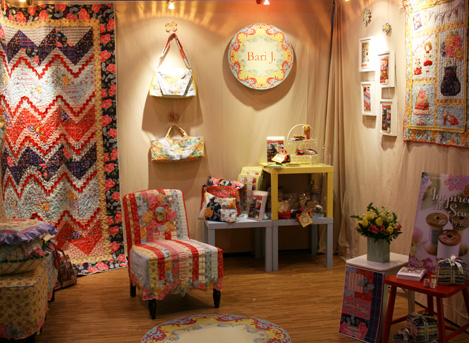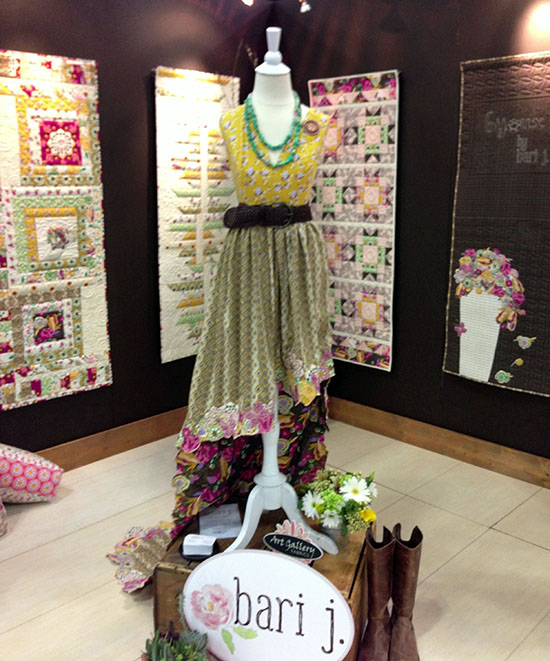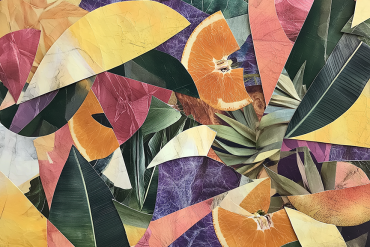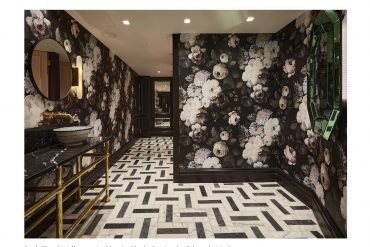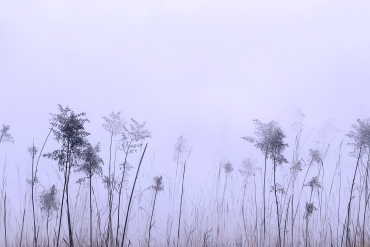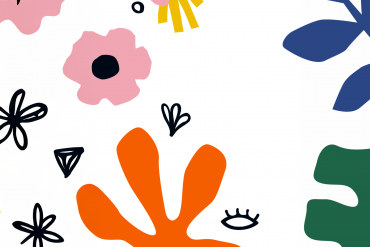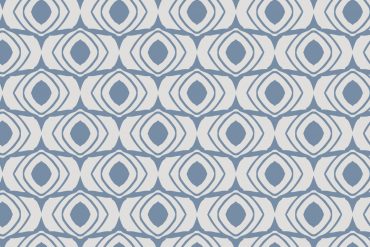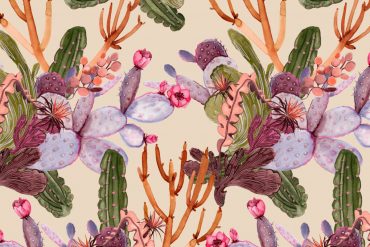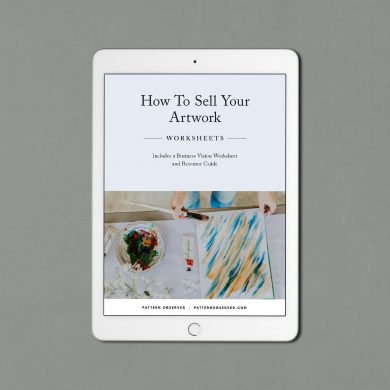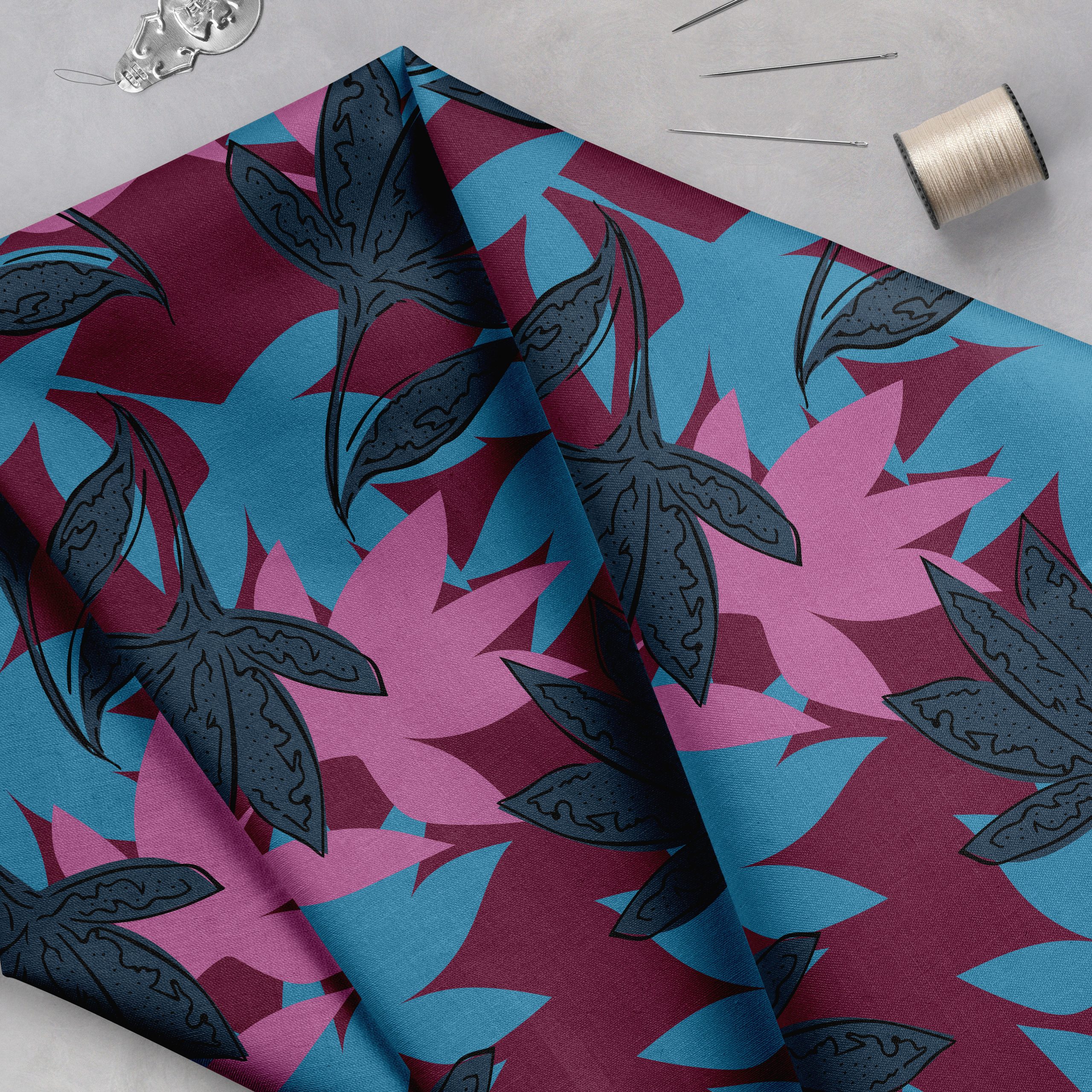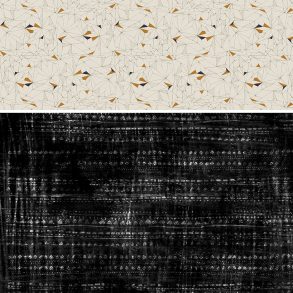Each month in The Textile Design Lab we welcome an industry expert who offers training in their area of expertise. We have been lucky to have Bari J. Ackerman of Bari J. Designs on board as our guest expert for the month of April! You can read more about Bari in our interview here.
In this excerpt from Bari’s in-depth training she provides tips and words of wisdom from her years of exhibiting at trade shows like Surtex and the International Quilt Market. There is tons more info to soak up in the full post so come on over and join us in the Lab to access the complete training!
My Background:
Prior to doing trade shows, I did a ton of consumer shows for my finished handbag line. Some of these required a lot of set up, some less so. However, I knew instinctively that the way to sell stuff was through great display. Of course, there was that one time I pushed a display dresser up a hilly street in San Francisco… in the RAIN! AND learned a whole lot about when to make big deal out of having a great display and when to make my life a heck of a lot easier. I could have avoided a lot of pain had I figured out the logistics in advance, so I’ll be talking a lot about that in this document.
After the consumer shows, I did Quilt Markets, which is the big fabric trade show that takes place twice a year. I’ve now done 4 displays within manufacturer’s booths and I’ll be doing my 6th full booths next month. I also did a booth at SURTEX which is one of the big art licensing shows. I have a lot of experience with displays and the general ins and outs of doing shows. I’m looking forward to sharing all of this with you.
Deciding to Exhibit. What to take into consideration.
• What will the return on your investment be and how long will it take to see it? Will you be able to measure ROI at all?
• If you can’t measure ROI, will there be some other benefit to attending such as brand building or possibly simply being taken more seriously in the marketplace. Are either of these things enough to justify the expense? How long might it take to recoup your investment?
When you decide to sign up for a trade show, you’ll want to read all about it on the trade show website. Before you sign up, there are a few things that I’d be sure to check on. One of the ways to figure out if you might be able to see a good return on your investment is knowing how many people will be attending the show, and in turn, how many vendors will be there. However, this comes with a great big caveat… For many shows, you’ll never know what the return on your investment is. With Quilt Market, for example, I’m either selling sewing patterns or fabric or both. However, my sewing patterns were sold mostly through distributors who are also at shows. My booth, basically becomes advertising for the patterns. However, shops like to buy through the distributors who I send them to.
As a side note, I keep a list of who I’ve sent over to the distributors and I ask the buyers a lot of questions. It’s good to know how many people you sent and where, so that when the sales come in later you can somewhat quantify how you got the sales. Although you will never know for sure.
With the fabric that I’m selling (marketing would be a better word), I never take an order. That’s all done through the fabric manufacturer. So, what am I doing at Quilt Market? Mostly, I’m brand building. I no longer sell sewing patterns, so I’m not making money on that directly. I’m just selling my fabric. But really I’m selling my brand. Yes, I make a good portion of my income on fabric. However, when I do a great booth at Quilt Market, that is a message to the industry that I’m a brand that has longevity. It shows buyers who I am in a very visible way. And this isn’t just to buyers who are AT Quilt Market. Social Media has made the show a virtual marketplace as well. The end user of fabric sees the booths via blogs, Instagram, Pinterest, and Faceb
ook. So you get more than just the people walking through the market seeing what you are up to. It’s important to make the most of this as well. I talk about a few of my ideas for getting seen beyond the trade show floor in the full post.
Since I know this show is really about marketing myself and branding my business, when I want to know just how visible a show the show I’m signing up for is. Ask these questions:
• Is this trade show blogged about a lot?
• Do I see it on social media?
• Are buyers that are not at the show and END USERS potentially seeing my booth on social media?
On the other hand, at SURTEX, there are some ways to measure ROI, but often, it simply takes a really long time to close the deal. At SURTEX, I found that I was mostly making the connections with Creative Directors that buy art for products. I could sell pieces outright and have numbers on that before I even leave the show (as opposed to licensing where the deal takes longer to close. You don’t typically close a licensing deal on the floor at SURTEX.), however, more often than not, I’m making the connection and then it’s all about following up. A few of the connections that I made last May at SURTEX, I’m still talking to, and a few I JUST got contracts with. It takes a long time. So consider that before you sign up. Consider too, if you are the kind of person who really will follow up. You’ll need seriously thick skin for all of this. You might consider hiring someone to do your followup if you know that’s not your gig.
There are those who would disagree, but I think that erring on the side of caution with trade shows is the way to go. For instance, I might not sign up for SURTEX in particular until I already had not just connections to contact ahead of time, but possibly a few contracts under my belt as well. This is just my opinion. I believe this because it is extremely costly. I’ve seen more than a few people recommend to just go for it. But in truth there are many other ways to get licensing contracts, and I’d highly recommend trying those routes first. Look at manufacturer’s websites and get submission guidelines to find out more.
The bottom line is that trade shows are costly and labor intensive undertakings that shouldn’t be entered into lightly. Make sure you know all the details, and all the costs up front before you sign up.
Take into consideration the following:
• booth fees
• signage
• booth giveaways and collateral material (including business cards, brochures, press kits if you are doing them etc.)
• booth furnishings (this includes absolutely everything you put in your booth including your walls because some trade shows do not include anything but cheap curtains and poles that you may not want to use… I even include the cost of all of my 3m velcro to hang things)
• lighting, electrical and communications (wireless connections if needed)
• shipping
• labor fees from the convention center (They charge you to receive your crates and boxes. Make sure you know the details beforehand about what you’ll be charged for. It’s all in the service booklet the trade show gives you.)
• fireproofing of materials (Sometimes that is required by convention centers and you have to provide proof that you did so. There are services that do it, and they are usually listed in the trade show service guide. This doesn’t include fabric that is for sale. Just display fabrics like curtains for the booth. Not quilts and other fabrics like that.)
• travel (planes, trains, automobiles… super shuttles and cabs too.
• hotel (consider finding a room mate)
• meals
I usually budget it all out and then add a large buffer for overages. I’ve actually been told to figure out what I’ll be spending and then plan on spending double. I’m not sure you need to be that extreme, but remember, there are all sorts of expenses that come up that you don’t think of to begin with. Knowing in advance is key. Ask anybody you know who has done a potential show what their thoughts are as well.
Become a Textile Design Lab member to gain access to the rest of Bari’s in-depth trade show training, which includes Bari’s suggestions on the steps you should take after signing up for a trade show, getting seen before and after a trade show and making the most of your trade show dollars. TDL Membership also comes with access to our private forum, frequent design challenges and variety of e-courses including Five Days to a Better Business, a brand new mini-course out today!!

